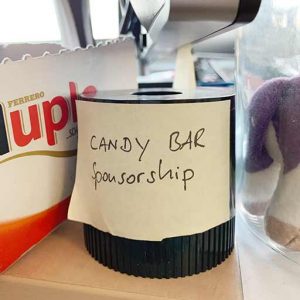
When designing digital products we, as UX Designers, deal with screens, pages, and page flows. We rarely get physical. Maybe sometimes we make paper prototypes for e.g. website navigation. But typically our experience doesn’t reach beyond digital.
Imagine areas where physical objects and digital applications merge. Think about a smart home use case, where things are interacting with associated apps. Software that, on a digital screen, lets you control the settings of a smart device. If you want to create a really good app for a smart home use case, you need to know how the physical object works.
A good app that controls a smart object must seamlessly bridge from physical to digital and vice versa. It must almost feel like touching the physical object itself. E.g. for switching a lamp on and off.


For the start, you don’t have to build anything very specific. It can also be something only physical. There are no rules, you can try out whatever you want. As a short exercise, just build something. It will help you to see various use cases and experiences through another lens. It will broaden your sense and push your boundaries.
My Prototype – Candy Bar Re-Funding
The photo at the beginning of this post shows the prototype that I’ve built some weeks ago. I wanted to test a concept for re-funding a colleague’s social initiative. This guy regularly buys candy bars and places them on his desk, to everyone’s chocolaty well-being, for free. We really appreciate him taking care of our mental health. But this makes some 10 to 15 Euros on his account—every week.
 So, when my bad conscience got bigger, I thought about, how to support him. But, also without forcing anyone to cover the exact amount of their consumption. And, without hurting the colleague’s need to do good to the community.
So, when my bad conscience got bigger, I thought about, how to support him. But, also without forcing anyone to cover the exact amount of their consumption. And, without hurting the colleague’s need to do good to the community.
I took a paper clip holder, took the clips out of it, and labeled a post-it with “Candy Bar Sponsorship”. Then, placed this very basic prototype on my colleague’s desk right near the candy bars.
Soon, the box started filling with coins. People contributed. Not enough to cover all costs, for sure. However, at least something. So everyone started doing good for the community. The concept proved to be working.
Why didn’t I just buy a piggy bank? Well, because I first wanted to test my re-fund concept, before investing in a real physical product. And, actually, it would have been a boring kind of task.
First Issue, New Requirements, Alternative Concept
One day I wanted to put 2 Euros in. But the coin didn’t fit in the throw-in hole. I hadn’t any other coins at hand. So, this time, no contribution from my side—unless I opened the box from the bottom with the screw cap. That’s what I did—Jingle, jingle, all coins fell out of the box. The fix, until now, is to turn around the box. But also not forget to cover the throw-in hole with the other hand, so that the coins won’t fall out the other way around.
Maybe security could be an issue? There’s no lock. Somebody could easily take out money off the box! But that’s very hypothetical, of course. We’re all good people 🙂
After all, it works well, and it could stay as it. But maybe I’ll think about getting him a solid and well-engineered pinky piggy bank.
Alternatively, I could think of creating a small donation website instead, connected to a Paypal account. But, I doubt that this would further optimize this use case.
Antithesis: this may lead to a decrease of the compensations, as it would decouple the two physical concepts. Eating candy bars and spending some coins every once in a while. They are building an immediate causal connection. As soon as the donation box is out of mind the probability of forgetting about the compensation will increase.
For me, no use case for the ChocoDonator App, as well.
Conclusion and More About Physical Prototypes
Building physical prototypes and pursuing the underlying concepts is fun. Especially when you see them succeed and making progress. The learning, independent from the test results, is valuable all the way. You train your ability to think outside the box and find more alternative solutions.
You’ll also better understand the connections between physical products and their digital associates (remember the smart device and the app). This will help you to bridge comprehensive use cases and to deliver seamless experiences.
Through building physical prototypes, you may also discover totally new use cases or even innovations.
In its 199th episode, the UX Podcast’s topic is Physical Prototypes. Kathryn McElroy talks about bridging the gap between physical and digital. She’s sharing her experiences from the world of prototyping with electronics as a “multi-modal designer”.
Credits: UX Podcast, @uxpodcast, and @kemcelroy

Leave a Reply to A/B Testing a Physical Prototype | UXygenic Cancel reply